WELCOME TO BENDIGO UFS
Your Community's Health and Wellbeing Destination
Your Community Pharmacy, Optical and Health Hub, Building a Healthier Bendigo Together
For over 150 years, Bendigo UFS has been more than just a pharmacy—we’re a not-for-profit organisation dedicated to supporting the health and wellbeing of our community. Every purchase you make helps us reinvest in local health initiatives, ensuring a healthier future for Bendigo.
How Can We Support You?
Explore our wide range of services designed to make your health journey easier.
Building a Healthier Bendigo
At Bendigo UFS, our commitment to community health extends beyond our pharmacy doors. Through initiatives like our $60,000 contribution to Bendigo Foodshare's 'Grow a Row, Pick a Branch' program, we've helped provide over 43,000 kilograms of fresh produce to those in need . Our partnerships with local organisations, including Red Energy Arena, further our mission to support wellness and connection across Greater Bendigo.
Bendigo UFS Optical
Your vision is our priority at Bendigo UFS Optical. Whether you need a comprehensive eye exam, stylish designer frames, or tailored children’s eyewear packages, we’ve got you covered.
Our experienced optometrists use advanced technology to detect and manage eye conditions, ensuring your eye health is always in focus.
Trusted Care for Over 150 Years
Bendigo UFS was founded in 1872 with a mission to provide accessible healthcare for all.
As a community-owned, not-for-profit organisation, we have grown alongside Bendigo, offering comprehensive pharmacy services, optical care, and innovative health programs. With over 11,500 household members, we remain committed to reinvesting into our community, funding vital initiatives and delivering personalised care.

Book a Health Service
Access trusted health advice and services tailored to your needs. From managing blood pressure to diabetes education and sleep apnoea solutions, we’re here to support your health every step of the way.
Become a Member
Join Bendigo UFS and enjoy more than just savings.
As a member, you’ll receive exclusive benefits like vouchers, unlimited nursing consultations, and points with every purchase, while also helping to support the Bendigo community. With 50% of all membership fees donated locally, your membership makes a real difference right here at home.

























